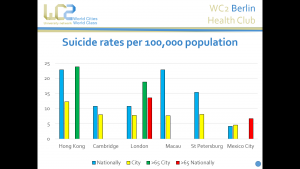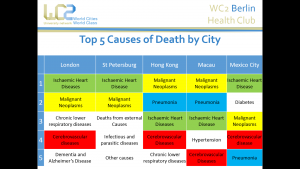
Students and academics from 11 Universities participated in the The World Class/World Cities (WC2) Symposium at TUBerlin in August 2016 to discuss the United Nation’s New Urban Agenda. In the Health Club, 27 students and academics from CUL London, HKPolyU, UAM Mexico and SPGSTU Petersburg first discussed similarities and differences between their cities for those ‘Ageing in Urban Environments’ and secondly shared their experiences of piloting a survey that incorporated the WHO quality of life questionnaire.
The New Urban Agenda is interested in promoting the development of small and intermediate cities as well as large cities. Post graduate students presented their secondary analysis of publicly available data on a range of cities which showed that in four regions female (women+girls) life expecancy was greater than male (men+boys) and there seemed to be greater difference between geographical regions than between sizes of cities where they worked.

The New Urban Agenda commits the United Nations
‘to address the social, economic,and spatial implications of ageing populations, where applicable, and harness the ageing factor as an opportunity for new decent jobs and sustained, inclusive,and sustainable economic growth, while improving the quality of life of the urban population.’
Participants from Hong Kong, a region with one of the ageing populations with the highest life expectancy, brought to the symposium a concern about suicide amongst older people in a context of over crowding and inadequate of social inclusion after retirement at age 60. A comparison of figures with other regions suggested that suicide rates are generally lower in cities (yellow) than nationally (blue), the suicide rates of older adults was higher than average nationally in England and Mexico (red) and the suicide of older adults was higher than nationally among older adults in the cities of Hong Kong and London (green).

Suicide is not identified in the New Urban Agenda and the causes of death morbidity and mortality given most space is road traffic accidents, particularly motorcycle deaths. However there is an attention to the needs of the most vulnerable in society: ‘women and girls, as well as children and youth, older persons and persons with disabilities’ and the prevention of other injuries and non-communicable diseases (paragraph 108). The risk of traffic accidents on the quality of life for older people in cities was discussed in the health club and may be taken up in future symposium in collaboration with the transport club. Comparisons of the top 5 causes of death across cities showed that non-communicable diseases has become the main cause of death in the cities studied by the club in a demographic change to ‘living longer and sicker’ instead of dying ‘quicker and fitter’ as Higgs and Gilleard (2016) have paraphrased an observation first made in the 1980s.

Chronic disease dominates this top 5. Heart Disease (green) and cancer (yellow) are in the top 3 for all the cities studied. Cardiovascular disease (red) is in the top 5 for 4 of the cities. Pneumonia (blue) is the second cause of death in Hong Kong and the nearby island city of Macau, suggesting that the cities face some of the same problems. But their 4th cause of death is not the same and cities in the same region face different problems. Mexico has a challenge of diabetes and St Petersburg ha a higher prportion of traumatic deaths than other cities.
After considering the different demographics of the cities the group moved forward to developing a strategy to find out about the experience of ageing in these cities where retiremnt age heath services and transportation make comparison of attitudinal data a challenge.


